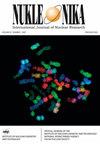水中氡测定方法的全国比较
IF 0.3
4区 物理与天体物理
Q4 CHEMISTRY, INORGANIC & NUCLEAR
引用次数: 0
摘要
摘要本文介绍了水样中222Rn测定的三个实验室间实验。前两次实验分别于2014年和2018年在Kraków使用波兰科学院核物理研究所辐射专业实验室(LER)制备的人工氡水进行。第三个实验是2016年在科瓦里前铀矿附近收集的自然环境水。在波兰进行水中氡测量的大多数机构都聚集在波兰氡中心网络,它们参加了实验。这些活动的目的是评价波兰实验室常规使用的不同测量技术以及实验室在水测量中对氡的熟练程度。在2018年进行的实验中,基于LER开发的方法计算了水中222Rn浓度参考值。参与者的结果似乎在低氡浓度下比在高氡浓度下更差。在此基础上得出的结论表明所使用方法的弱点,可能也包括抽样的弱点。从术语上讲,实验室间实验可以帮助提高参与者的技能和结果的可靠性。本文章由计算机程序翻译,如有差异,请以英文原文为准。
National comparison of methods for determination of radon in water
Abstract The article describes three interlaboratory experiments concerning 222Rn determination in water samples. The first two experiments were carried out with the use of artificial radon waters prepared by the Laboratory of Radiometric Expertise (LER), Institute of Nuclear Physics, Polish Academy of Sciences in Kraków in 2014 and 2018. The third experiment was performed using natural environment waters collected in the vicinity of the former uranium mine in Kowary in 2016. Most of the institutions performing radon in water measurements in Poland were gathered in the Polish Radon Centre Network, and they participated in the experiments. The goal of these exercises was to evaluate different measurement techniques used routinely in Polish laboratories and the laboratories’ proficiency of radon in water measurements. In the experiment performed in 2018, the reference values of 222Rn concentration in water were calculated based on the method developed at LER. The participants’ results appeared to be worse for low radon concentration than for high radon concentrations. The conclusions drawn on that base indicated the weaknesses of the used methods and probably the sampling. The interlaboratory experiments, in term, can help to improve the participants’ skills and reliability of their results.
求助全文
通过发布文献求助,成功后即可免费获取论文全文。
去求助
来源期刊

Nukleonika
物理-无机化学与核化学
CiteScore
2.00
自引率
0.00%
发文量
5
审稿时长
4-8 weeks
期刊介绍:
"Nukleonika" is an international peer-reviewed, scientific journal publishing original top quality papers on fundamental, experimental, applied and theoretical aspects of nuclear sciences.
The fields of research include:
radiochemistry, radiation measurements, application of radionuclides in various branches of science and technology, chemistry of f-block elements, radiation chemistry, radiation physics, activation analysis, nuclear medicine, radiobiology, radiation safety, nuclear industrial electronics, environmental protection, radioactive wastes, nuclear technologies in material and process engineering, radioisotope diagnostic methods of engineering objects, nuclear physics, nuclear reactors and nuclear power, reactor physics, nuclear safety, fuel cycle, reactor calculations, nuclear chemical engineering, nuclear fusion, plasma physics etc.
 求助内容:
求助内容: 应助结果提醒方式:
应助结果提醒方式:


